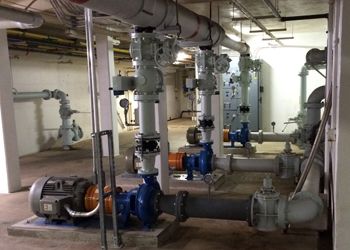
 Sometimes the required operating conditions for a system are beyond the reach of a single, standard pump. Rather than purchasing a heavy duty pump that may be far more than you need, consider taking advantage of system design strategies to combine simple pump performances that add up to the necessary requirements. The following post walks you through pumps in series and in parallel so that you can get your ducks… I mean pumps… in a row – or side by side, depending on the application.
Sometimes the required operating conditions for a system are beyond the reach of a single, standard pump. Rather than purchasing a heavy duty pump that may be far more than you need, consider taking advantage of system design strategies to combine simple pump performances that add up to the necessary requirements. The following post walks you through pumps in series and in parallel so that you can get your ducks… I mean pumps… in a row – or side by side, depending on the application.
Putting your centrifugal pumps in series, or connected along a single line, will let you add the head from each together and meet your high head, low flow system requirements. This is because the fluid pressure increases as the continuous flow passes through each pump, much like how a multi-stage pump works. For example, if two of the same pumps are in series, the combined performance curve will have double the head of a single pump for a given flow rate. For two different pumps, the head will still be added together on the combined pump curve, but the curve will most likely have a piecewise discontinuity (meaning to curve with protusions as pictured in in the 2nd pump curve below). For help on reading centrifugal pump curves, check out our previous post: How to Read a Centrifugal Pump Curve.
As the system pressure builds, remember to consider the pressure ratings of the downstream pumps and seals to avoid equipment damage!



In situations where a high, constant pressure is required, consider adding speed control to the final pump in a series. This configuration achieves the high pressure that is needed, while keeping a low flow, because the fixed-speed pump feeds into the speed-controlled pump, which adjusts its output with a pressure transmitter to add only enough head to maintain a constant pressure.

Putting your pumps in parallel, or connected to any number of line branches so that each handles a division of the flow, will help you reach a low head, high flow operating point that a single pump cannot supply. Additionally, this system configuration gives you flexibility by permitting the switching of parallel pumps on or off in order to adjust to variable flow conditions.
Going back to our pump curves, the combined curve for parallel pumps is created from the addition of the flow capacities of each pump. Two of the same pumps will result in double the flow while two different pumps will result in the addition of the flows.



In cases where a variable flow and high efficiency is required, consider adding speed control to each pump to achieve good performance and to operate pumps closer to their best efficiency point (see the Untold Story of Pump Performance Curves & Reliability for more on this!). In this configuration, two scenarios can occur: either one pump can fully run while the other adds flow when needed, or both pumps can run at reduced speed and adjust as needed.
Running a pump at full speed causes you to move past the BEP on the right side, lowering efficiency and causing potential issues. With two controlled pumps operating at partial capacity, you can still have control over the flow while running each pump closer or to the left of its BEP, resulting in a more efficient operation. Overall, this configuration offers a wide range of operating conditions and opportunities for better efficiencies in order to meet your variable flow needs.


If you’re looking to pump under special operating conditions or need help with variable flow, ask us about it! We gladly provide technical assistance to businesses in Wisconsin and Upper Michigan.
These Stories on Pumps
Headquarters and Service Center
Located outside Green Bay, WI
707 Ford Street
Kimberly, WI 54136
920-733-4425
OptiFlow Design and Build Center
1002 Truman Street
Kimberly, WI 54136
920-733-4425
Burnsville Service Center
12265 Nicollet Avenue
Burnsville, MN 55337
952-444-1949
Grand Rapids Service Center
26489 Industrial Blvd
Cohasset, MN 55721
952-444-1949
© Copyright 2024. Crane Engineering. All Rights Reserved. Privacy Policy.